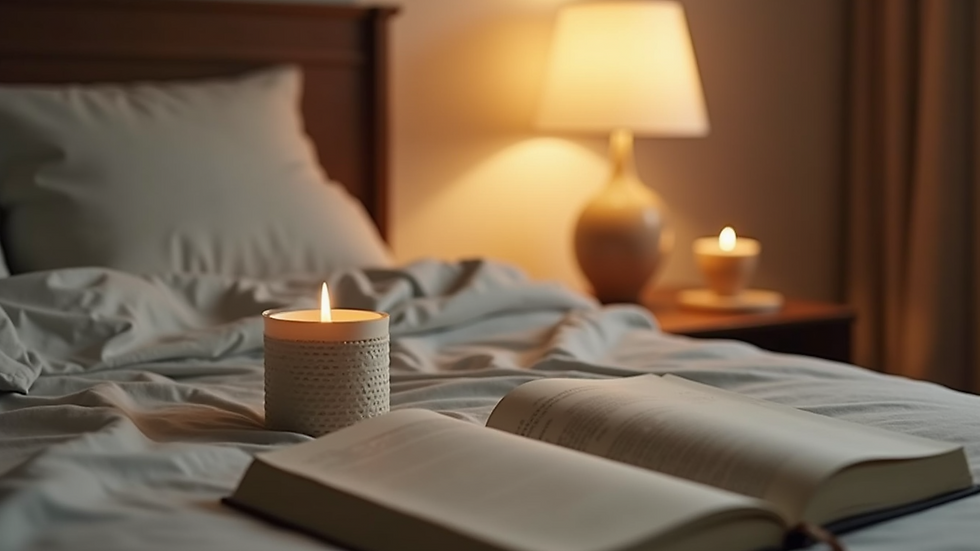Transform Your Nights with Guided Sleep Meditation
- Sep 29
- 4 min read
Struggling to fall asleep or stay asleep can be frustrating and exhausting. Many people turn to medication or other quick fixes, but these often come with side effects or only provide temporary relief. A natural and effective alternative gaining popularity is sleep meditation. This practice helps calm the mind, relax the body, and prepare you for a restful night. In this article, you will discover practical sleep meditation techniques that can transform your nights and improve your overall well-being.
Understanding Sleep Meditation Techniques
Sleep meditation techniques are designed to guide your mind and body into a state of deep relaxation, making it easier to drift off to sleep. These techniques often involve breathing exercises, visualization, progressive muscle relaxation, and mindfulness practices. The goal is to reduce stress and anxiety, which are common barriers to good sleep.
Here are some popular sleep meditation techniques you can try:
Deep Breathing: Focus on slow, deep breaths. Inhale through your nose for a count of four, hold for seven, and exhale through your mouth for eight. This breathing pattern activates the parasympathetic nervous system, promoting relaxation.
Body Scan: Mentally scan your body from head to toe, noticing any tension or discomfort. As you identify these areas, consciously release the tension.
Guided Imagery: Imagine a peaceful place, such as a beach or forest. Engage all your senses to make the scene vivid and calming.
Mindfulness Meditation: Focus on the present moment without judgment. Observe your thoughts and feelings as they come and go, gently bringing your attention back to your breath.
Practicing these techniques regularly can help train your brain to associate bedtime with relaxation, making it easier to fall asleep naturally.

How to Incorporate Sleep Meditation Techniques into Your Nightly Routine
Creating a consistent bedtime routine that includes sleep meditation techniques can significantly improve your sleep quality. Here’s a step-by-step guide to help you get started:
Set a Regular Sleep Schedule: Go to bed and wake up at the same time every day, even on weekends.
Create a Relaxing Environment: Dim the lights, reduce noise, and keep your bedroom cool and comfortable.
Limit Screen Time: Avoid screens at least 30 minutes before bed to reduce blue light exposure, which can interfere with melatonin production.
Choose Your Meditation Technique: Pick one or combine several techniques that resonate with you.
Use Guided Meditations: If you’re new to meditation, guided sessions can provide structure and support.
Practice Consistently: Dedicate 10-20 minutes each night to your meditation practice.
By following these steps, you create a calming pre-sleep ritual that signals your body it’s time to wind down.

What is the Best YouTube Video for Sleep?
YouTube offers a vast selection of sleep meditation videos, making it easy to find one that suits your preferences. The best videos typically feature soothing voices, gentle background music, and clear instructions. Here are some tips to find the right video for you:
Look for Guided Meditations: Videos that walk you through breathing exercises or visualizations can be very helpful.
Check Video Length: Choose videos that match the time you want to spend meditating, usually between 10 and 30 minutes.
Read Reviews and Comments: Feedback from other viewers can help you gauge the effectiveness of a video.
Try Different Voices and Styles: Some people prefer soft-spoken narrators, while others like nature sounds or binaural beats.
A popular choice is a guided meditation that combines deep breathing with calming imagery, helping you relax quickly and deeply. Experiment with a few videos to discover what works best for your unique needs.

Benefits of Sleep Meditation Beyond Better Sleep
While the primary goal of sleep meditation is to improve sleep quality, the benefits extend far beyond just a good night’s rest. Regular practice can positively impact various aspects of your health and daily life:
Reduced Stress and Anxiety: Meditation lowers cortisol levels, helping you feel calmer and more balanced.
Improved Mood: Better sleep and relaxation contribute to a more positive outlook.
Enhanced Focus and Productivity: Restful sleep supports cognitive function and memory.
Lower Blood Pressure: Relaxation techniques can help reduce hypertension.
Pain Management: Meditation can decrease the perception of pain and improve coping skills.
Incorporating sleep meditation into your routine is a holistic approach to wellness that nurtures both mind and body.
Tips for Maximizing the Effectiveness of Sleep Meditation
To get the most out of your sleep meditation practice, consider these practical tips:
Be Patient: It may take time to notice significant improvements. Consistency is key.
Avoid Heavy Meals and Caffeine Before Bed: These can interfere with your ability to relax.
Use Comfortable Props: Pillows, blankets, or eye masks can enhance comfort.
Stay Mindful During the Day: Practicing mindfulness throughout the day can make nighttime meditation easier.
Seek Professional Guidance if Needed: If sleep problems persist, consult a healthcare provider or a meditation coach.
By integrating these tips, you can create a sustainable and effective sleep meditation habit that transforms your nights.
Embracing sleep meditation techniques can be a game-changer for your nightly rest. Whether you choose deep breathing, guided imagery, or mindfulness, these practices help quiet your mind and prepare your body for sleep.




Comments